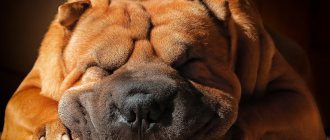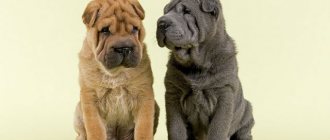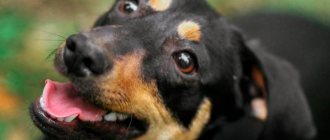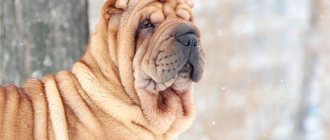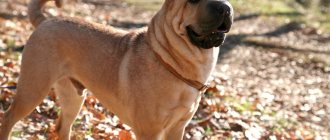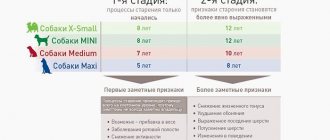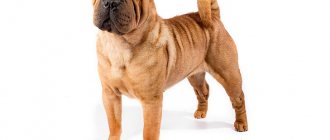Breed characteristics
| Short description | |
| Origin: | China |
| Conditions of detention: | Any conditions other than constantly being on the street |
| Purpose: | Companion, home security |
| Color: | Almost all types of solid colors except all white, with or without black mask |
| Wool length: | From 0.8 cm to 2.6 cm |
| Adult dog size: | Height from 44 to 52 cm, weight 20 – 25 kg |
| Average life expectancy: | 9 – 11 years |
| Walk: | Mandatory, at least twice a day |
| Physical activity needs: | Average need, from one and a half to two hours a day |
| Fédération Cynologique Internationale (FIC) classification: | Group 2: Pinscher and Schnauzer, Molosser, Mountain and Swiss Cattle Dogs; Section 2: Molossians |
| Puppy price: | From 10,000 rubles “sofa” puppies, up to 50,000 rubles show class |
Breed standard
Characteristics of the breed standard :
- The dogs' height is 44-51 cm, and their weight is 18-35 years. Life expectancy is about 10-12 years.
- The head is powerful and large, folded. The folds do not cover the Shar-Pei's eyes and do not interfere with them in any way. Smoothly transitions into a dewlap around the neck. The muzzle is wide and without narrowing.
- Scissor bite. The teeth must be complete. The color of the palate, gums and tongue should be dark purple or lavender. Pigment spots on the tongue are allowed, but not completely pink color.
- The nose is black and large, the nostrils are open.
- The eyes are oval or almond shaped and should be dark in color. Their expression is calm; due to their overhanging eyebrows, they may be frowning, but no more; aggression or anger is not allowed.
- The body is square, the neck is strong, the back is wide. The harness should not interfere with the dog's movement.
- The limbs are powerful and confidently placed. Must be without folds. The feet are arched and the toe must be removed.
- The tail is thick and strong, curled into a ring.
History of the origin of the species
It is not known for certain where the history of the origin of the Shar Pei began . It has just been established that this is one of the oldest breeds. The first mentions of these dogs are found already in 206 BC. During archaeological excavations, figurines of dogs were found that were very similar to today's Shar Pei.
Representatives of the Shar Pei breed are among the top 5 most ancient dogs. The Shar Pei is believed to be a direct descendant of one of the 4 basic aboriginal breeds from which all current dogs descend.
The Chinese have a comic legend. They say that before, Shar Peis weighed about 80 kilograms. In the process of evolution, the dog became smaller, but the skin remained the same size, hence their folds.
According to one version, representatives of the breed descended from ancient smooth-haired Chow Chows, and it was from them that the Shar Pei acquired a blue tongue. The Chinese believe that the blue tongue, like an amulet, wards off evil spirits.
In the 60s, due to the policies of communist China, dogs were declared an unaffordable luxury that took away a piece of bread from the working people. Owners and breeders were taxed, and the number of breeding dogs began to decline rapidly.
By the late 60s, only a few individuals remained in Hong Kong. Then, one of the connoisseurs of the breed turned to the USA for help, and thus saved the Shar-Pei from extinction. The dogs were taken to the United States. In order to increase the number of livestock, Chow Chows were mixed with Shar Peis, thereby obtaining a modern type, heavier, with brushed hair.
In China, Shar-Peis are still lighter, with horse-hair. At the moment, the FCI is raising the question of dividing the breed into 2 types - American and Chinese.
The Shar Pei was listed in the Guinness Book of Records as the rarest breed in 1978 . But thanks to enthusiasts who worked to restore the breed, by 1983 it was reborn. Now their genes contain the blood of not only chow-chows, but also bullmastiffs, bulldogs, boxers and bull terriers.
The history of these dogs in Russia began in 1991 . The first breeding pair were imported but, unfortunately, these natives died. A repeat attempt was successful in 1993. It was possible to obtain offspring from the imported couple.
Types and their descriptions (with photographs)
Today there are several types of Shar Pei. But the standard does not distinguish any separate types. Any dog that competes for the right to be called a Shar Pei must obey the description specified in the regulations.
American
There is still debate about whether the American variety of Shar Pei can be recognized on an equal basis with the Chinese.
“Americans”, unlike “Chinese”, are taller. They have long legs, representatives of this species are lean, and the withers are better defined.
Also, the American type is distinguished by a much smaller number of folds on the body. Their muzzle is more tucked up, the upper lip does not hang so low over the lower lip.
“Americans” have a smaller nose, and their eyes are clearly highlighted against the background of their muzzle . Among them, the most common are black or even monochrome individuals in color.
European
This type of breed was developed in Europe. Outwardly, it is very similar to its Chinese counterparts. The main changes occurred in the transformation of character.
The British, through long selection and crossing, obtained a dog that is most similar in character to the people of this country.
Such Shar-Peis are distinguished by even greater calm and almost complete absence of aggression. In this variety, the dog has turned from a watchman into an animal whose guarding skills have been dulled. European Shar Peis are phlegmatic, they prefer leisurely walks and are sedentary.
Over time, the dogs acquired a slightly different appearance than the original.
The structure of the body has changed, so in Europe they look much smaller than their counterparts, and the shape of the body has changed from square to more rounded, which once again emphasizes their inactive lifestyle.
These Shar-Peis are called so because of their incredible resemblance to a bear . They have a long, soft, fluffy, shaggy and flowing coat and are more similar to the Chow Chow than the Chinese variety.
The fact is that Chow Chows also took part in the restoration of the breed. Dogs with long hair appear due to the fact that the genes of a long-haired animal are expressed to a greater extent in an individual.
But this feature is considered a defect. “Bears” are disqualified from participating in exhibitions.
You won’t find such dogs in China, but in America, Russia or Europe they are not uncommon.
We recommend reading: Puppy Has Bloody Diarrhea After Vaccination
Many unscrupulous owners deliberately cut such Shar-Peis, turning them into “purebred” dogs for a while, but such manipulations are often discovered.
Distinctive features
The main breed traits of the Shar Pei:
- Height. The height at the withers for females is from 44 to 50 cm, for males from 46 to 52 cm.
- General form. A compact dog with strong bones, moderate sanding, but clearly visible.
- Head. Relative to the body, it is large, brick-shaped, flattened, with a well-filled cushion. bite , tongue and palate blue. The ears are small, triangular, the tips of the ears are slightly turned up (ideal standard). Small, deep-set eyes , brown in color, lighter ones are allowed in delta colors. The muzzle is wide, does not narrow toward the nose, and has fleshy chins that cover the lower jaw.
- Neck. Moderately short, strong, strong with good dewlap
- Frame. Square format. The back is straight, without arching, strong and wide. The loin is short and wide. The chest is deep and wide. The stomach is moderately tucked.
- Limbs. Straight, squat, strong, parallel to each other. The shoulder is sloping, with well-defined muscles. Hock joints dropped.
- Tail. Set high, short, thick at the base, tapering towards the end. It is twisted into a ring over the back.
- Coat and color. Two types of coats: horse - coat length up to 1 cm; brush – the length of the coat is from 1 to 2.5 cm. There is no undercoat, the outer coat is hard. Almost all basic colors are acceptable, except solid white. All types of delta colors, except completely white.
- Sexual dimorphism. Weakly expressed, but its presence is welcome.
Description of the breed
Proportional, even in length and height, the Shar Pei can be up to 51 cm at the withers. And the body weight is 19-29 kg. Characterized by a wide chest and the presence of wrinkles throughout the body.
The dogs are very strong, and the presence of folds is only misleading. The tail is short and in the form of a ring of regular shape.
It is distinguished by a large head with a muzzle and skull of approximately equal size. The entire head is covered with folds. The tongue and gums have a blue-black tint.
There are animals with a black nose, but, as a rule, its shade matches the color of the coat. Triangular ears are small in size, their tips droop towards the eyes.
The characteristics of the description of the Shar Pei breed are due to the elasticity of the skin, which is very hard. The dogs have a single straight coat that is smooth to the touch. In some varieties the fur may become very loose, creating a prickly feeling.
There are short-haired, long-haired types, as well as Shar-Peis with “bear hair”.
Pigmented color with black pigment having varying intensities and can vary widely. There are about eight such shades - this includes a pure black version, fawn, cream, red, etc.
Also popular are 6 dilutes with no black pigment - chocolate, apricot, cream, etc.
Photo of an adult dog
Photos of puppies
Features of character and behavior
Shar Peis are called philosopher dogs, this speaks volumes about their behavior. Calm, balanced, thinking, independent, independent and unobtrusive friends of a person. They do not like fuss, are not inclined to conservatism, are leisurely, even a little imposing - these are the real breed traits of the Molossian aborigines.
Many people believe that Shar Peis are stupid dogs due to their training habits. But the Chinese, who call them thinkers, say that the labyrinths of the mind appear on their foreheads.
Many are sure that the Shar Pei is a fighting breed; in Russia and Belarus it is included in the list of potentially dangerous dogs, but this is complete nonsense.
Due to the movable skin, they were actually tried to be used in battles in the 17th century, but this idea was soon abandoned due to the lack of aggression. Moreover, not a single canine organization in the world recognizes such a thing as a “fighting breed”.
The Shar Pei is an absolutely versatile dog. Previously, they were used for hunting, protecting houses and livestock. We fought against mongooses that attacked peasant birds. For a short time they were even used as shepherds. Today it is a companion dog. People who have encountered a Shar Pei at least once call them thinking or understanding companions.
Treats strangers arrogantly, with distrust, but without aggression . With a good level of socialization, he does not show aggression at all. But in the manifestation of his feelings he will be restrained, like a true eastern sage. If the dog is in complete social deprivation, or rarely leaves the territory of its territory, it may exhibit protective qualities.
They love their family members endlessly, although sometimes they can be stubborn. Children are treated tolerantly, especially female Shar Peis. The maternal instinct in female dogs is so developed that they can become excellent nannies for a child.
They may seem a little phlegmatic or even melancholic, do not fetch fetch, and are indifferent to toys after changing teeth. But during hunting or playing with their brothers, they turn into playful, perky puppies. It becomes unclear where these lazy people get so much energy.
There may be some difficulties in communicating with brothers.
Shar-Peis, especially during the growth period, have a rather loose structure of the nasopharynx; with rapid breathing, wheezing can be heard, which some dogs may perceive as a growl and respond with aggression.
In addition, Shar Pei has a rather specific smell that is not characteristic of domesticated dogs. Representatives of this breed are recommended to make friends who are the same age since childhood, then there will be no problems.
Advantages
The Shar Pei has many advantages. A very smart, calm, balanced dog. A true Eastern philosopher, with all that implies. He doesn’t make unnecessary movements, doesn’t show aggression, knows how to restrain his emotions, and doesn’t impose his company. He even has some intelligence, aristocracy and neatness.
The French have a saying: “If you walk down the street with a Shar Pei, don’t be surprised if no one notices you.”
The main advantage of the Shar Pei is its appearance. A dog of extraordinary beauty, incredibly cute and unusual exterior. Literally translated, “Shar Pei” means a sand dog; when you pet them, you get the feeling that sand is rolling in your hands.
Flaws
Not suitable for sports training, obeys commands lazily and reluctantly. Before carrying out an order, he must be given time to think. He has a stubborn temperament and an independent character. Speaking in “human” characteristics, he is touchy. Absolutely not suitable for any types of services (police, Ministry of Emergency Situations, etc.).
Care and maintenance
The Shar Pei is not fussy about keeping. Can be kept in a small apartment, with two walks a day. And in a private house, with the condition of living in a warm room.
Shar Peis do not have an undercoat, so prolonged exposure to the street leads to hypothermia - in the cold season, to overheating - in the heat.
There is an opinion that Shar Peis need special care because of their wrinkles. That the skin between the folds is rotting, has an unpleasant odor and needs to be wiped every day. It is a myth! This dog's wrinkles are a natural condition and do not require any special care.
The dog's eyes require careful attention. Small puppies have much more folds than adults. Sometimes wrinkles interfere with deep-set eyes; the upper eyelid can completely cover the eyeball. For this purpose, veterinary clinics have several special procedures that solve this problem once and for all. The owner will only have to regularly wipe the pet’s eyes with a sponge soaked in a special lotion.
Shar Pei ears, in the absence of any diseases, do not need deep cleaning. It is necessary to wipe only the upper part of the ear from dust. If there are signs of otitis, deep cleaning is also not performed. The suspension is instilled into the ear, without rubbing with cotton swabs or other equipment.
Nails should be trimmed as needed. This must be done carefully, without damaging the internal living tissue. A breeder, groomer, or veterinarian can show you how to do this correctly.
During the period of teeth change, the dog should have “chew” toys. They help loose baby teeth fall out and avoid crooked molars. You can use either special toys from a pet store or large beef bones. An uncut beef rib or large knuckle bones are ideal. In any case, the bone should be of such a size that the puppy cannot swallow it or choke on it.
Nutrition
Shar Pei breeders encourage feeding them with ready-made grain-free food. Premium, super premium or holistic food.
These are fully balanced diets for dogs, enriched with all the necessary vitamins and minerals for the healthy development of the dog.
It is quite difficult to independently create a truly correct diet for a Shar Pei, especially in the first year of life. This breed, despite its compact appearance, is a giant-growing dog and reaches the size of an adult by 6–7 months. During the period of active growth, the foundation for the pet’s health is laid. An incorrectly selected diet can lead to serious consequences with the bones or immune system. Therefore, you should not take risks; it is better to entrust food to professionals.
All food manufacturers indicate the amount of food consumed per day depending on the dog’s weight. Food for puppies and adults should be different; to select the correct diet, you must contact the breeder.
We recommend that you read a detailed article on the topic: “How and what to feed a dog: types and characteristics of nutrition.”
Health
Until the beginning of the 21st century, Shar Peis were considered one of the sickest dogs. Gradually, thanks to conscientious breeders and nursery owners who do not allow sick animals into breeding, the breed has become much healthier.
The time of countless allergies, pathologies and curvatures of the limbs, constant otitis media and entropion of the eyelids has passed. Of course, all these diseases still occur in Shar-Peis, but much less frequently.
With the right approach to feeding and raising a puppy, many health problems can be avoided. To do this, you need to carefully listen to the recommendations of veterinarians and the breeder.
Vaccinations
The vaccination schedule is the same for all breeds. At approximately 6 weeks , the entire litter is dewormed along with the mother. After two weeks, the breeder repeats the procedure for preventing helminths.
Only after this is the first vaccine against viral infections such as Carré's disease, enteritis and hepatitis given. Depending on the region, the veterinarian may recommend an additional vaccine against the virus that lives in a particular area. After about 4 weeks, the vaccine is duplicated to consolidate the effect.
By this time, you can already get vaccinated against rabies. The last injection is given at the age of 7 to 12 months with the same vaccine. Further, the drugs are injected once a year along with anti-rabies serum.
Until the puppies have received their second vaccination, quarantine must be observed.
Communication with other dogs is prohibited, with the exception of the mother and littermates. Taking the puppy outside is also prohibited.
If your pet feels unwell on the day of helminth prevention or after vaccination, do not be alarmed - this is a natural reaction to the drug. Lethargy, drowsiness, one-time or two-time refusal to feed, and a slight increase in body temperature by 0.5 - 1 degree .
Allergic reactions are possible in theory, but in practice they are very rare.
Important article on the topic: “Everything you need to know about dog vaccinations.”
Diseases
The most common diseases in Shar Pei:
- Otitis;
- Allergy;
- Entropy;
- Amyloidosis
- Entropy;
- Entropion;
- Atopy;
- Enteritis;
- Intertrigo;
- Seborrhea;
This is not a complete list of diseases that Shar Pei can suffer from. The main problem areas are the eyes, ears, and skin . But, as mentioned above, diseases are becoming less common, thanks to the painstaking work of breeders.
Breeders recommend that upon reaching 4 years of age, they undergo an examination every year at a veterinary clinic, take a urine test and a biochemical blood test. In order to identify possible diseases in the primary stages and get rid of them as quickly as possible.
Walk
Shar Peis do not require special walking conditions. Despite the lack of undercoat, there is no need to dress them in winter; they can easily tolerate a couple of hours in the cold.
A walk of 40 to 60 minutes twice a day is enough for them Shar Peis are not very active dogs; a short, leisurely walk is enough for them.
Puppies up to one and a half years old need a little more time to splash out their energy. After that one hour is enough.
Grooming
Careful grooming is not required . Due to the lack of undercoat and short guard hair. In spring and autumn, during the molting period, it is necessary to free the dog from dead hairs with a furminator a couple of times a week. The rest of the time, no more than once a month.
There is no need to wash your Shar Pei at all in winter, so as not to wash away the natural fatty film on the skin, which prevents the dog from freezing. In spring and autumn, after walks, you can rinse your stomach and paws from dirt. Fully washing more than once a month is not recommended.
How to care for Shar Peis
These dogs are unpretentious in grooming, but they do require regular brushing. The disadvantage is the susceptibility to molting, especially during seasonal periods. For short-haired species, this problem is less pronounced.
But remember that Shar Pei fur is a serious allergen.
Particular attention should be paid to caring for wrinkles, especially on the face. After all, this is where leftover food and water accumulate. The accumulation of fat and dirt can lead to serious inflammation.
Questions often arise about what to feed your Shar Pei. The animal's body needs animal protein. Therefore, you should choose foods rich in these elements.
We recommend reading: Signs of an Early Childbirth in a Cat
Three main feeding schemes can be used:
Natural food consisting of 3/4 protein-containing foods and 1/4 raw vegetables that have been pre-grated. You can add meat, poultry, and fermented milk products to your food. At the same time, the animal tears up the food, which means it is necessary to give the meat in pieces. There is no need to douse them with hot water.
Feeding with complete dry food. It must be premium or super premium. In this case, you must follow the dosage; you should not often change the brand of food; it is important to carry out regular deworming. The risk of developing allergies in the animal should also be taken into account.
Mixed diet of natural food and dry food. It is important to follow the regime here - you need to feed twice. The first time, dry food is used, and the second time, meat or various offal. Mineral supplements are helpful.
But you can’t mix food with meat. It is permissible to soak the food in warm water or mix it with fermented milk products.
However, compared to the ancient ancestors of the breed, modern dogs look less athletic, they have more folds and have become smaller at the withers.
Mating
Mating is allowed for males aged 18 months and older. Bitches are at 4 sexual estrus, but not earlier than they are one and a half years old. The dog must have time to fully develop to avoid problems with the bones.
Sick individuals or those with disqualifying exterior defects are strictly not allowed for breeding.
A male dog can inseminate at least every month. Bitches are prohibited from being bred more than once a year; this will lead to exhaustion of the body and a high probability of giving birth to sick offspring.
Estrus occurs on average, as in all breeds, on the 10th – 14th day of estrus. Depending on the individual characteristics of the organism, these data may vary from -2 to +4 days .
Read a detailed article on the topic: “Everything you need to know about breeding dogs: appropriate age, what to do if it doesn’t work out, rules and tips.”
Fluffy Shar Pei puppies
The photographs below show puppies of one of the most charming and sweetest dog breeds - the fluffy Shar-Pei. These dogs are very cute at absolutely any age, the only thing is that while they are small, they have, as they say, “increased fluffiness,” which makes them unusually beautiful.
The photographs below show puppies of one of the most charming and sweetest dog breeds - the fluffy Shar-Pei. These dogs are very cute at absolutely any age, the only thing is that while they are small, they have, as they say, “increased fluffiness,” which makes them unusually beautiful.
Key points in training
Aboriginal breeds, which include the Shar Pei, are considered one of the most difficult to train. It is not recommended for beginners in dog breeding to engage in training on their own. It is necessary to contact professional dog handlers and animal psychologists who work on the basis of conflict-free training. Or raise a pet under the strict guidance of a breeder.
This breed needs to be able to be interested in activities, then you can get a well-bred dog.
Read about how to properly train a dog in the article: “Training a puppy: effective methods from dog handlers, learning commands at home.”
How to choose a puppy
The main criterion in choosing a puppy, not only a Shar Pei, but any other breed, is health. It is necessary to remember that sick parents will not give healthy offspring. It is important to pay attention to the health status of the future pet’s parents and littermates. There should be no “sores” on the skin, discharge from the eyes, ears, or nose. Puppies should be moderately well-fed, strong, playful, and inquisitive.
You cannot buy a puppy of “elite blood” at the poultry market . You need to choose only reputable breeders or large nurseries.
At the time of sale, the puppy must have a puppy card or pedigree and a veterinary passport indicating all manipulations carried out with the puppy.
You should buy a dog only after passing the first stage of socialization - no earlier than 2 months of age.
Shar Pei is a dog for calm, balanced, strong-willed people. You cannot treat the Molosser as a toy, otherwise it will show the true character of the native. Shar Pei demands respect for himself, and the relationship is equal, only then will he respond in kind.
Appearance of puppies
Appearance of puppies at different ages:
- 1 month . At this age it is still too early to adopt a puppy into the family. He is still attached to his mother and other brothers, moreover, he still needs his mother's milk. A dog at this age is covered with many folds, which is why it looks touching. The legs are still short, as is the tail, which is too early to curl behind the back.
- 2 months . This is the age when you can already take a Shar Pei to your home. It's still covered in funny and cute folds, but they don't hang off it as much. The puppy has grown noticeably compared to last month. The legs have lengthened, and the tail is already curled.
- 3 months . This is the time to start training. The puppy has grown noticeably, the folds have become much smaller, only the eyebrows hang over the eyes, and the upper lip remains larger than the lower one.
- 4 months . A period of active growth. The puppy begins to socialize, at this time you need to start introducing him to other dogs. The folds still remain on the dog's body, but they are almost invisible. The proportions of an adult dog begin to be guessed in the pet.
- 5 months . The folds on the body are smoothed out and remain only on the face and withers. The dog becomes even larger, its legs lengthen. Puberty will begin soon, but in the meantime, your pet may begin to fight for the right to be the main one in your relationship.
- 6 months . The period of development of the puppy's personality continues. If the last stage was completed successfully, then now the dog will become incredibly loyal to you. The Shar Pei is becoming more and more like an adult animal. At this time, male dogs may begin puberty.
- 7-9 months . The dog's growth and weight gradually slows down. By 9 months, the Shar Pei has already fully acquired the appearance of an adult. By 8 months, female dogs may go into heat.
- 10-12 months . The final completion of growing up. By the age of one year the dog reaches its harmonious size. The psyche is also completing its formation. From this stage it will be difficult or almost impossible to retrain or re-educate the Shar Pei.


